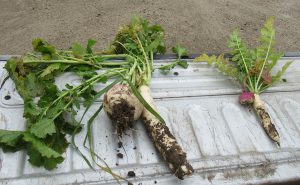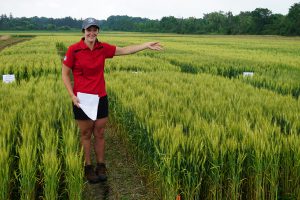Field observations
SUMMER 2019 UPDATES
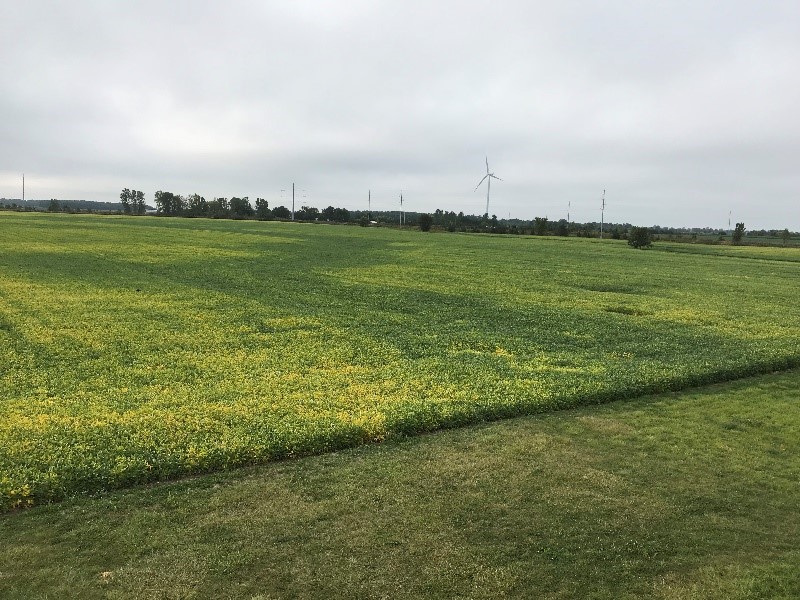
Update for September 13, 2019
IT WAS A busy week in Ontario for farmers as Canada’s Outdoor Farm Show was held in Woodstock. Soybeans have begun to turn while the corn crop needs some more heat for the next three to four weeks.
CORN
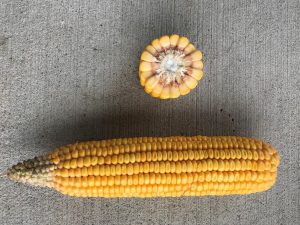
Corn across the province is in the dent stage (R5) this week. Once grain corn has hit the R5 stage, hard starch begins to be laid down on the cap of the kernel which in turn starts to firm up the kernel. As this hard starch layer is formed over the next three weeks, you will notice the difference of this progression as the tip of the kernel will be soft and milky while the cap is hard and starchy. The line between this is called the milk line. The colour difference will be evident as the cap will be yellow and the tip will be white. As the milk line progresses, the kernel becomes drier, the husks brown up, and the whole plant begins to dry down. This is the time silage producers start to evaluate crops for maturity and moisture and begin to prepare for silage harvest. Full grain maturity is still a good three to four weeks away for most corn. Once the milk line has disappeared, a black layer (abscission layer) will form; this will indicate the corn is mature and will be in the 32% moisture range.
SOYBEANS
Maturity is starting to set in on the soybean crop this week. Green fields last week have started to turn yellow this week. Some of the maturity has been hastened by the drier weather and lack of adequate rain near the end of the growing season, as is evident with the uneven ripening in fields with lower areas of the field remaining green. Maturity differences in varieties and planting date are also showing up as the crop is reaching maturity.
Pre-mature die down in the soybean crop will lead to smaller seed size and result in a loss in the top end yield of the crop. While rainfall this week will keep the green areas green and continue to size up the soybeans.
Lower lying areas of fields will remain greener as higher areas ripen earlier due to drought stress over the past few weeks.
CEREALS
Spring cereals in northern Ontario and slowly coming off in-between the rains. Harvest delays have occurred due to late spring planting and a wetter harvest period.
Winter wheat planting will begin shortly on unseeded acres. If growers are looking to plant winter wheat on cover crop acres, remember to control the cover crop with a herbicide application at least two weeks before planting the winter wheat to allow for enough time for the cover crop to die down.
CANADA’S OUTDOOR FARM SHOW
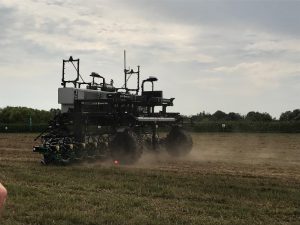
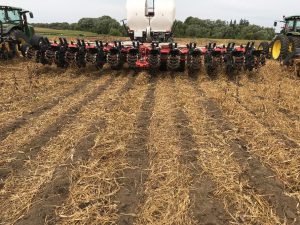
There was a lot to see and learn this week in Woodstock. New equipment and new technology were showcased at the show as farmers were able to also see live demonstrations on the Tuesday of strip tillage, cover crop tillage, and we got to see DOT run. Fully autonomist farm equipment for planting, spraying, and fertilizing was in full operation.
Update for August 30, 2019
CORN
Corn growth stage this week is now at late dough (R4) to early dent (R5) stage. Yes – fields from Chatham to Guelph have started to dent. Depending on heat accumulation, the crop will still need 30 days before black layer (physiological maturity). Cool nights will slow the grain fill process and add more days required to mature the crop.
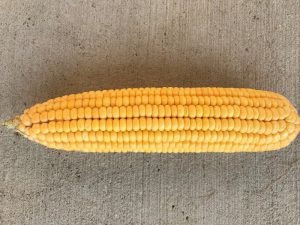
You should not expect any more kernel abortions at this time. From here on in it’s all about kernel weight. Any stress at this time will reduce the kernel weight and affect yield through lighter kernels. Yield estimates at this time are a bit more accurate as final kernel number is set and all you need to guess is the number of kernels it will take to fill a bushel or make up 56 lbs.
Corn Yield estimate
What you need to calculate
- Number of average ears per acre.
- Number of average kernels per cob (kernel rows x kernels per row)
- Estimated number of kernels in 56lbs or in a bushel (90,000
Calculation
Average ears per acre
Multiply
Average number of kernels
Divided by estimated kernels per bushel
Example
30,000 average ears
16 kernel row by 38 kernels long = 608 kernels per cob
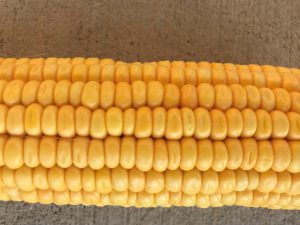
Kernel weight 95,000 per bushel
30,000 x 608 ÷ 95,000 = 192 bushels/acre
Your yield estimate is all dependent on your averages and your kernels per bushel factor. If you think corn is going to be small or light, use 100,000 kernels per bushel. If kernels will be heavy using 90,000 may be more appropriate. In this example, 5,000 kernel difference per bushel makes 10 bu/acre difference in the calculation. Grain weight will matter to your final yield. Getting heat in September will make the corn crop.
Update for August 30, 2019
VARIABLE RAINFALL ACROSS the province this week left some geographies lacking in moisture, while others have received abundant rainfall. A couple of cooler nights have signaled that fall is around the corner. Disease pressures continue and plant stress is showing signs of crop weakness in areas across the province.
CORN
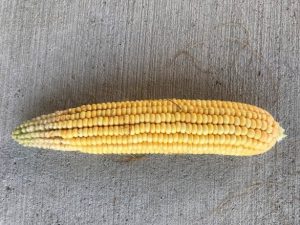
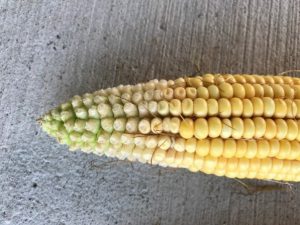
Corn growth is in the milk (R3) to dough stage (R4). Dry weather in the last 10 days has had a detremental affect to the crop in drier regions. Lack of moisture at this stage has caused kernels to abort starting on the tip of the ear. The butt end of the cob is the first to be filled as it is the closest to the stem and the first to receive the flow of sugars from the plant. When stress conditions occur, such as lack of moisture or lack of nutrients, pollinated kernels will be aborted as the plant runs short of sugars. Adequate moisture from here on in will allow the plant to continue to produce sugars and fill the remaining kernels. Test weight at this time will be deterimined by the amount of sugars the plant can produce and store in the kernels before plant death occurs now that kernel numbers have been set. If inadequate conditions occur, there is a risk of continued kernel number drop and poor grain fill resulting in shallow kernels and lighter test weight.
During pollination this summer, many fields with ideal moisture had two ears pollinated per plant. Depending if continual moisture conditions occurred or not, the second ear may or may not produce any kernels.
In the photo at the top, the first ear is fully pollinated and has maintained all kernels, the second ear also has been pollinated but under drier conditions had all kernels aborted, leaving just the shell of the pollinated ovule. Depending on plant competition due to plant population, some plants on the outside rows of the field, or fields with lower plant stands, may have second ears producing grain. You should avoid looking at the exception and look at the majority of the field in the crop canopy. The optimal productivity target for your population and fertilizer program is to produce a single complete ear. Scout your fields to understand how your target population and fertility program worked this year. If you have many second ears with kernels, consider increasing your target population for similar field conditions (soil type, fertility, rotation, moisture) in the future. If you continually experience too much tip back, consider adjusting your fertilizer program or reduce your target population.
SOYBEANS
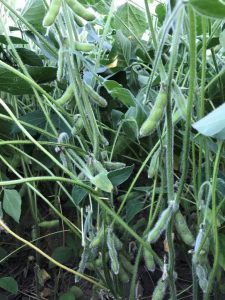 Soybean maturity across the province ranges from beginning seed (R5) to full seed (R6) stage. By R5 stage, 25% of the yield has been made, by R6 stage 50% of the yield has been made. At this stage of seed development, you can tell when stress hit the crop. Clusters of pods within the canopy tell when conditions were good, and lack of pods indicate when stress occurred and deterred reproductive development such as flower set and pod set.
Soybean maturity across the province ranges from beginning seed (R5) to full seed (R6) stage. By R5 stage, 25% of the yield has been made, by R6 stage 50% of the yield has been made. At this stage of seed development, you can tell when stress hit the crop. Clusters of pods within the canopy tell when conditions were good, and lack of pods indicate when stress occurred and deterred reproductive development such as flower set and pod set.
Yellowing spots in soybean fields are the early warning signals to a farmer of trouble within the field. Check your crops for possible causes so corrective measure can be implemented in future years. There is a whole list of possible causes, and it may be a combination of factors. Problems can be caused by nematodes, spider mites, diseases such as sudden death, or nutrient deficiencies such as potash. It could also be water holes, compaction, or dry spots. No two fields or problems are alike, make sure you scout and diagnose your warning signs.
Update for August 23, 2019
VARIABLE SHOWERS ACROSS the province this week missed some who needed some rain and delivered more excess volumes than needed. Crop conditions remain variable across the province.
CORN
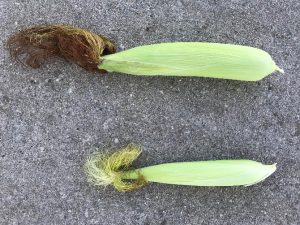
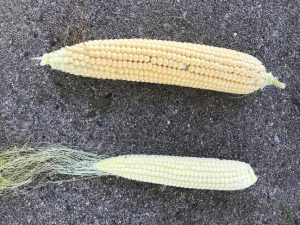 Development of corn in the province is in the blister (R2) to dough stage (R4), with the majority of the crop at the milk stage (R3). If you ever wondered why you have some ears in the fall that have incomplete kernel set or poor tips, now is the time to find the answers.
Development of corn in the province is in the blister (R2) to dough stage (R4), with the majority of the crop at the milk stage (R3). If you ever wondered why you have some ears in the fall that have incomplete kernel set or poor tips, now is the time to find the answers.
Late emerging plants or stressed plants that are delayed will pollinate late. The late silking of these ears will not receive pollen, or very little pollen and lack of fertilization of the ovules will result in lack of kernel set. Doing the shake test as discussed last week will show the silks still attached to the delayed plant. Pollen shed is done in this field and no more kernel set will occur.
SOYBEANS
Developing soybeans are just finishing off their top flowers and setting the remaining pods. The next few weeks are critical in the bean development as size of beans are determined. Stress at this time will lead to bean abortions and abortions of the top pods.
CEREALS
Growers looking for 2019 winter wheat yield data will find there will be very little plot data this year. Just like the wheat crop, plots suffered great losses. In the interest of making good sound decisions, it is advised that farmers look to multi-year, multi-location data sources to find new products they would like to add into their stable of products grown on the farm for this year. There will not be a 2019 winter wheat report from the Ontario Cereal Crop Committee this year, please use the 2018 report as your data source. The report can be found at www.gocereals.ca.
Update for August 16, 2019
WINTER WHEAT IS harvested, spring grains have started, the corn is pollinated, and what happened to the soybeans?
CORN
The corn crop has nicely pollinated over the past two weeks and is now in the blister stage. It’s good to see the late planted corn pollinated as it’s the middle of August. Pollination completeness can be checked by looking for dry silk ears, remove an ear from the plant and remove the husk carefully as not to remove the silks. Turn ear upside down and shake the ear. Any fresh silks that remain on the ear are an indication that the ovules didn’t pollinate, and a kernel will not form unless more pollen is in the field from later plants. If you find ears in the field with fresh silk, try the same technique to see how much pollination has occurred. Second ears on plants and sections of the field that were under stress will be more delayed than the main ear on the best part of the field. Once the pollen from the tassels are done, pollination will be complete for the year. This year you will find lots of variation within the field. This is a good check for the next few weeks as kernels develop on the ear and you can track the grain development.
Western Bean cutworm flights have past their peak and egg masses are hard to find. Drier weather has slowed the disease pressure.
SOYBEANS
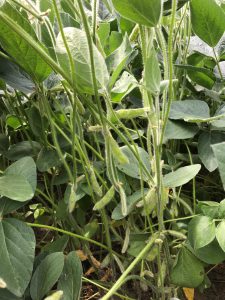
Dying spots are appearing in soybean fields where water is limited. Soybeans will need moisture through the month of August to fill pods and produce good size beans. Drier areas will see reduced yields through pod and seed abortion and smaller seed as the crop develops in the month. Some of the drought appearance is caused by small root system due to wet spring conditions. But also check for diseases like sudden death or nematode damage. Dig some plants, wash the roots, cut some stem. Understanding the true cause today will help prevent reoccurrence in the future.
CEREALS
Winter wheat harvest is wrapped up in the south and harvest is still underway in the north. Spring grain harvest is also underway.
Cover crop planting in wheat stubble is occurring and will continue as farmers apply manure and prepare the soil for the cover crop establishment.
Update for August 9, 2019
VARIABILITY CONTINUES, IT seems to be the theme for 2019. Whether it’s rainfall, heat, or dry periods, we are experiencing great variability across the province. We are also seeing great variability within communities and within fields. There is something about a wet spring that just brings the ugly out in a field. Many corn fields as they tasseled this week showed tremendous variability in plant to plant pollination.
CORN
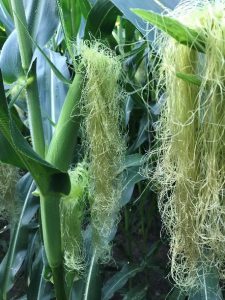
The majority of the corn crop has pollinated this week with a few remaining late fields that should be pollinated by next week. On average, it will take 60 days from pollination to physiological maturity, also known as black layer. So, an August 6 pollination means a possible October 6 black layer. It is at this stage when the kernels abscission layer (black layer) forms. At black layer, sugar will no longer flow from the plant to the kernel and at this time kernels will be at the 32% to 35% moisture range. Its at this point where grain accumulation has maximized and yield has reached full potential. The importance of this is that the crop after black layer will not have any reduction in dry matter caused by a frost.
SOYBEANS
Pod development is occurring across the province and the continuation of favourable moisture conditions will help fill pods. Dry conditions at this time will lead to pod and seed abortions and lower yields.
CEREALS
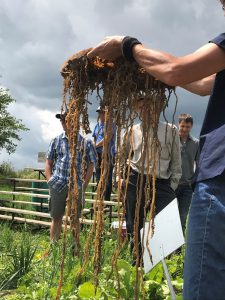
Winter Wheat harvest is wrapping up in the majority of the province. Spring cereals will be next on the list to harvest.
UPCOMING EVENTS
A very successful compaction day was held by the Elgin Soil and Crop Association in Shedden this week. There were lots of cover crops to evaluate and soil pits to climb into in order to evaluate their root developments. Tillage equipment
demonstrations showed their impact on compaction layers and tires, tracks, and air pressures were all measured for their impact on soil compaction.
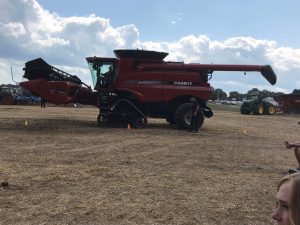
We certainly have come a long way in the past decade on the understanding and measuring of compaction. Now we need to implement better tools to elevate and prevent compaction for the betterment of our soil health.
Update for August 2, 2019
SEVERE STORMS EARLIER this week brought strong winds, small hair, and scattered rainfall through parts of Ontario. These storms damaged corn and wheat crops.
CORN
In corn, ripped leaves have been reported due to hail and wind damage. Snapped stalks are also a concern due to the rapid growth of the plant between the V10 and early tassel stage; stalks are more brittle and rigid at this time making them more sensitive to snapping in heavy winds. This is referred to green snap and is dependent on three key factors: wind, genetics, and growth stage. All three are needed for the event to occur.
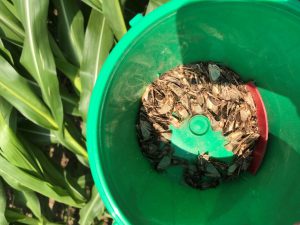
Also appearing is root lodged corn, plants are leaning to lodged. The cause of root lodged corn is shallow rooted plants with wet soil and wind conditions. Lodged corn will rebound, and goose neck up while placing down more anchor roots to stabilize itself. Greensnap plants will not rebound and no ears will be produced, dropping your yield expectations.
Western bean cutworm (WBC) moths are filling up traps this week. Keep looking for egg masses. The recommended threshold for control is when you have found five per cent of plants with egg masses. Remember if you need to control, you will need to apply when larvae are active and have not entered the plant. Typically this is at silking (R1 to R2) in order to protect the corn ear from damage and reduce infection sites where mould can develop.
For more information on WBC refer to http://fieldcropnews.com/wp-content/uploads/2019/07/WBC-Scouting-and-Management-2019-Corn-Final.pdf.
SOYBEANS
Soybeans are in full flower and early pod development is starting to appear in early planted fields. Yellow spots are starting to appear. It’s best to get into the field and diagnose the problem as it could be a whole list of causes. It’s best to know now what problem you have so corrections can be made now or addressed in the future.
CEREALS
Winter wheat harvest slowed down earlier this week due to the rain storms. Harvest picked up again as conditions allowed from mid-week on. Yield reports are in the range of 40 to 110 bushels per acre, with some farmers commenting their best fields are just bringing average yields for the farm. Poorer stands of wheat are yielding around 50% of average.
Oats are showing rust development and this will cause dustier conditions at harvest. Rust has not been shown to be toxic but may add to the level of irritant to those with dust sensitives.
Upcoming Events
August 7 – Compaction day at Shedden Fairgrounds, hosted by Elgin Soil and Crop Improvement Association.
Update for July 26, 2019
IT HAS BEEN a nice summer week with a few showers and moderate heat to keep the crop progressing in development. Few signs of drought stress showing in a some pockets of the province were soils are dryer and plant root development is limited. Some good looking crops and some very ugly looking crops. 2019 will be a year of huge variability in everything crop related.
CORN
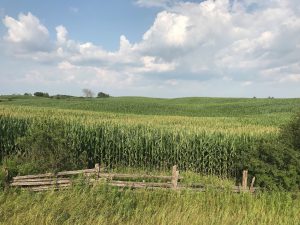
First fields of commercial corn in tassel have been spotted. These are the early to mid-May planted corn, of which is very few and far between. Will expect bulk of the corn crop to pollinate over the next two weeks.
Western Bean cut worm moth counts continue to build in the province. Larger numbers of moths appearing in traps in southwestern Ontario during this week. Start scouting fields for egg masses
Diseases of northern leaf blight and gray leaf spot have been reported in the US. Keep scouting to check on disease development.
SOYBEANS
Soybeans are flowering and will continue to develop over the next month producing more flowers and pods. Canopy’s across the province are starting to fill in on narrow rows, but for the most part canopies are thin and short for this time of year. Continual moisture and heat will help to further develop the crop. Current canopy and weather forecast indicates a low risk for white mold development for my field, but check your risk level by using the Sporecaster app. Can be downloaded from the app store under “Sporecaster”. Dense canopy and higher moisture conditions in the canopy will contribute to white mould development, which may not be the case with this late planted crop. Will be field by field specific.
While scouting soybean fields, keep an eye out for Japanese beetles, I have seen them in soybean fields and in grape vines this week. Defoliation is currently minimal but is starting and needs to be monitored.
CEREALS
The later part of this week has given to some favourable drier weather. This has allowed for winter wheat harvest to continuing across southern Ontario. Harvest is in progress from Essex to Niagara regions and parts in between. Lots of straw in wind rows and many fields already baled.
Update for July 19, 2019
HEAT AND MOISTURE have helped develop the corn and soybean crops this week. Winter wheat harvest has begun in the province. Insect pressures are building. Keep scouting as disease and insects are everywhere.
CORN
The first Western Bean Cutworm (WBC) moth of the season appeared last week in an Ontario trap. Ohio had moth flights a week earlier and has seen an increase in moth counts this week, it is still not peak flight, but it is building. Prepare to start scouting for egg masses in the upcoming weeks, which is later than normal. (http://fieldcropnews.com/wp-content/uploads/2019/07/WBC-Scouting-and-Management-2019-Corn-Final.pdf)
SOYBEANS
Some herbicide injury showed up in the last week. This would have been caused by the change in growing conditions earlier this month when plant development was under cooler, cloudier conditions and pesticide application occurred when weather changed to be brighter and warmer. Application of pesticides, during brigh and warm days when plants were growing more actively with a thinner cuticle, are more at risk of leaf burn due to a magnifying effect of the product applied. This is normally caused by the surfactants in the mix. Fields are more affected where other stress factors are a concern as well.
CEREALS
Winter wheat harvest has started in southwestern Ontario. Fields planted early last fall over-wintered well and had an ideal cool moist spring to further develop tillers and extend the grain fill period. Better than expected yields will be showing up due to the favourable weather conditions during the winter wheat crop development period. The thinner, even stand fields experienced excellent tillering and the crop has filled in better than expected. Dead wheat spots in fields have just become a weed seed bank and will reduce overall field yield.
Spring cereals planted in March as frost seeding also experienced the same favourable growing conditions as the winter wheat crop and expectations are very good; but acres are very limited as the planting window was only hours, not days this spring. For most of the spring cereals, planting occurred when ground conditions dried – which was one to two months later than normal. This has put the spring cereal crop into a late pollination period of mid-July. Spring cereals are pollinating and grain filling now during our current heat spell, expectations are for reduced grain development and the continual heat stress on the spring cereal crop will negatively affecting cereal yields.
During this week’s central Ontario cereal tour, rust was showing up in the oat and spring wheat plots. Disease pressure from Septoria was spread throughout the canopy and on the flag leaf. The disease pressure will take a bite out of the yield on the spring grains. Cereal leaf beetle damage was also showing up in many locations and insecticide sprays have been going on for control.
Update for July 12, 2019
Summer really started to hit its stride with some hot and even hotter July weather. This drier weather definitely allowed for more field operations to occur. Getting caught up on weed control applications in corn and beans were a priority as well as nitrogen applications on the late planted corn crop.
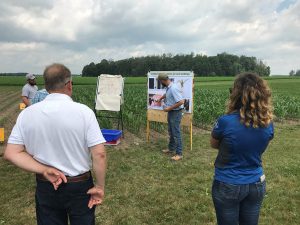
This current week’s weather seems to be just an average July as far as temperature and rainfall, but some crops are looking like the dry weather is affecting them. Those are generally fields that the roots system hasn’t developed in, and those systems may not develop properly this season due to excessive moisture at planting.
Tile runs patterns are very evident on the heavier soils this week. The crop above the tile runs are darker green, taller and overall in better health, while between the runs are lighter in colour and shorter. It’s a good idea to check root systems in the two different areas. For the plants in between the tile, look for how the roots are developing, and if they are flat along the trench, you guessed it – sidewall compaction and smearing. This form of vertical compaction limits root growth. Over the tile you should find normal developed roots that are growing in all directions that take up the maximum amount of nutrients for the plant to grow develop.
FARMSMART EXPO
FarmSmart Expo was held at Elora Research Station July 11. It was an excellent summer day with great speakers with informative sessions. The group that I participated in had great questions and was really engaged with the presenters. Topics were soybean management, banded fertilizer in corn with zone till, cover crop options, crimping rye for no-till, tank-mix concerns, tile drainage, cover crops as feed, newest types of soil monitors, and tractor tire discussions. The show had many great hands-on demonstrations.
CORN
The early planted crop looks tremendous and has really taken up the nitrogen. Yield potential at this stage is excellent, we just wish we had more of it. The bulk of the rest of the corn crop is hit and miss with some fields that were planted wet and are now suffering, while other fields are just a little uneven and will produce average crop.
SOYBEANS
Some of the no-till June planted beans are looking pale green, since growth stage is just V2 or V3 and the root system hasn’t fully developed. Checking out the roots you will notice there are no nodules yet. Once nodulation starts, then the plant will be able to fix nitrogen and will darken. Remember, with lower soil N this year due to cooler spring, plants will not be able to get the extra N from the soil and will have to rely on fixing its own nitrogen.
At FarmSmart this week Horst showcased the “Sporecaster” app that can be down loaded on your smartphone. The app forecasts your risk of mould spores. The app uses your location and the local weather forecast to estimate and recommend whether to spray or not. You need to indicate if beans are flowering or not. There are many other factors that affect your mould infection, like crop density, plant growth/canopy, and variety susceptibility. Make sure you look at all your factors. This app is just one tool that can help you identify future conditions that may be conducive to sporulation.
WHEAT
It’s rumored that Essex has begun wheat harvest this week. Fields across the province are ripening up and harvest will continue east and north over the next two weeks. Managing the variable crop within the field will be a challenge for farmers.
Update for July 5, 2019
July is here and so is the summer heat. Corn is soaking up the sun and heat unit accumulation is topping out as we are receiving warm humid nights, kind of tropical, just what corn likes.
Southwest Crop Diagnostic Days were held this week at Ridgetown as they celebrated 25 years. Excellent work by the organizing committee and by the team that put on the Diagnostic Days. Our appreciation goes out to them as this is a great way for the agricultural community to get together and discuss the field concerns farmers may run across and help keep everyone’s skills and knowledge up-to-date. It was great to see so many new and young faces in agriculture.
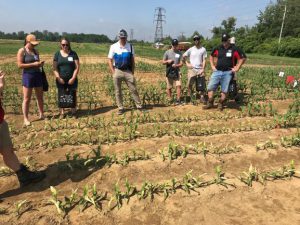
As they wrapped up the busy days, several volunteers from the Southwest Crop Diagnostic Days team also put on a mini diagnostic clinic with three local 4-H field clubs. What a great opportunity to show the 4-H members some of the different cropping practices and techniques. With corn, Ben Rosser discussed different tillage techniques and their impact, as well as covering off how to check seeding depth at the V4 stage. Dave Bilyea discussed the environmental impact on weeds and crops as carbon dioxide is increasing and temperatures are changing. Doug Young discussed the affects of cover crops and the different types of cover crops available. Hands on learning is just what makes 4-H programs work. Thanks to all those that organized, volunteered, and sponsored the event.
CORN
Corn fields are starting to show signs of the wet spring. As most of the crop was planted in less than ideal conditions, prolonged heat stress on plants are depleting plants of moisture, resulting in the drought symptom of leaf rolling. There may be moisture in the ground deeper, but smaller or restricted root systems can’t get to it. Due to wet planting, the seed disc opener smeared the ground causing sidewall compacting and trenching. This is a great opportunity for growers to dig up plants and identify the differences between the good sections of the field and the poorer sections of the field to help identify possible concerns. Make notes, so when you see the yield monitor in the fall you can quickly identify if it was the planting conditions restricting yield or maybe something else. Good information leads to good decisions. Continual rain showers will be needed to support the crop to maturity.
SOYBEANS
Lots of soybeans kept being planted in the last 10 days, until rains put a stop to things again this week. The July 5 planting deadline for crop insurance is here. For those areas that have not been seeded, farmers will be able to claim for the unseeded acre benefit. Now the focus will be on keeping unseeded acres free from weeds and preventing problems in following years. Cover crops are great at suppressing weeds and a great way to improve soil structure for the future.
At Southwest Crop Diagnostic Days, Horst Bonner highlighted a great little app to help farmers quickly evaluate their soybean plant stands. It’s as easy as taking five pictures. The app is called the “Bean Cam” and was developed by the University of Wisconsin. Search “Bean Cam” in the app store and you should find it. When you start with it, you will need to select the growth stage and then point and click above a spot in the field. Depending on your conditions (growth stage, weed pressure, etc.) you may need to calibrate it to be more accurate. Take a couple of manual counts, just to make sure you are close. University of Wisconsin created the app to help farmers with replanting decisions. Bohner indicated that the data they used for replant aligns closely to our values. There is a bit of a glitch when populations are under 50,000/acre, that will be fixed with the next update. Like all good tools, always double check with common sense.
WINTER WHEAT
Early fields are starting to have a bit of golden colour to them. Currently, the province is in the grain fill period. Rains and cooler spring temperatures have been favourable for the wheat that remained and grain filling will be good this year. With cooler, wet weather also comes the risk of disease, fusarium is now starting as pollination is the infection period and now as kernels are filling the damage can start to be seen. Continue to monitor your field so you are prepared to make adjustments at harvest.
For updates from Spring 2019 click here. •









